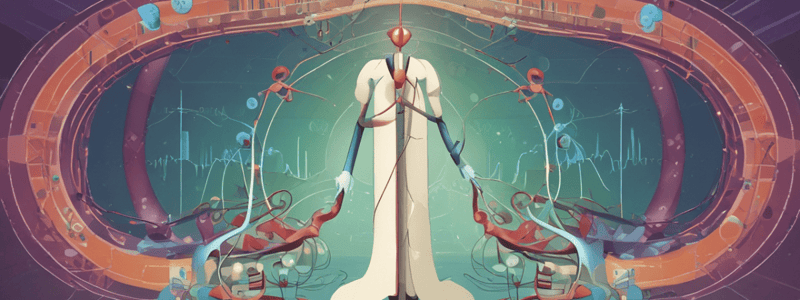Podcast
Questions and Answers
What is the primary goal of concurrent monitoring in healthcare?
What is the primary goal of concurrent monitoring in healthcare?
- To automate data sources for quality assurance
- To secure measurement of quality care standards
- To identify areas for improvement in patient care (correct)
- To evaluate the performance of the staff
Which of the following is NOT a type of quality assessment?
Which of the following is NOT a type of quality assessment?
- High volume case assessment
- High risk assessment
- Chart recognition
- Certification (correct)
What is the purpose of identifying standards of criteria in healthcare?
What is the purpose of identifying standards of criteria in healthcare?
- To secure measurement of quality care (correct)
- To identify areas for improvement in patient care
- To take action and make improvements
- To evaluate the performance of the staff
What is the role of the quality council in healthcare?
What is the role of the quality council in healthcare?
What is the main objective of high risk assessment in healthcare?
What is the main objective of high risk assessment in healthcare?
What is the purpose of reviewing data in healthcare?
What is the purpose of reviewing data in healthcare?
Which data collection tool is used to record observations and events over time?
Which data collection tool is used to record observations and events over time?
What is the purpose of a flowchart?
What is the purpose of a flowchart?
Which diagram is used to identify potential causes of a problem by organizing them into categories?
Which diagram is used to identify potential causes of a problem by organizing them into categories?
What is the primary purpose of a Pareto Diagram?
What is the primary purpose of a Pareto Diagram?
Which tool is used to visualize data distribution, showing the frequency of observations within specified ranges?
Which tool is used to visualize data distribution, showing the frequency of observations within specified ranges?
What type of chart is used to monitor process stability over time?
What type of chart is used to monitor process stability over time?
Which diagram is used to show the relationship between two variables, one being dependent on the other?
Which diagram is used to show the relationship between two variables, one being dependent on the other?
Which of the following tools would be most appropriate to use when trying to understand the root causes of customer complaints?
Which of the following tools would be most appropriate to use when trying to understand the root causes of customer complaints?
Which of the following is NOT a characteristic of quality improvement (QI) in healthcare?
Which of the following is NOT a characteristic of quality improvement (QI) in healthcare?
Which of the following is NOT a benefit of quality improvement in healthcare?
Which of the following is NOT a benefit of quality improvement in healthcare?
Which quality improvement tool is specifically designed for reducing a long list of options to a shorter list of prioritized choices?
Which quality improvement tool is specifically designed for reducing a long list of options to a shorter list of prioritized choices?
What is the primary goal of brainstorming as a quality improvement tool?
What is the primary goal of brainstorming as a quality improvement tool?
What is the key benefit of focusing on 'Timely' care as a quality improvement principle?
What is the key benefit of focusing on 'Timely' care as a quality improvement principle?
What does the principle of 'Effective' care in quality improvement refer to?
What does the principle of 'Effective' care in quality improvement refer to?
Which quality improvement principle is directly related to minimizing risks and harm to patients?
Which quality improvement principle is directly related to minimizing risks and harm to patients?
How can 'Staff workload' be considered a factor in quality improvement?
How can 'Staff workload' be considered a factor in quality improvement?
Flashcards are hidden until you start studying
Study Notes
Quality Improvement in Healthcare
- Quality improvement is a formal approach to analyze performance and improve it systematically.
Characteristics of Quality Healthcare
- Safe: Minimize risks and harm to patients, avoiding preventable injuries and medical errors.
- Timely: Reduce delays in providing and receiving healthcare.
- Effective: Provide services based on scientific knowledge and evidence-based guidelines.
- Efficient: Deliver healthcare in a manner that maximizes resource use and avoids waste.
- Patient-Centered (Family-Centered): Provide care that takes into account patient needs.
- Staff Workload: Minimize staff turnover and burnout (Occupational Safety & Health).
Quality Improvement Tools
- Brainstorming: A group creativity technique to find solutions to specific problems.
- Multivoting: A method to reduce large lists of options to top priorities.
- Data Collection Tools: • Checklists • Check sheets • Surveys • Log books • Medical records
- Flow Chart: A diagram showing step-by-step flow of operations to solve problems.
- Cause and Effect Diagram (Fish Bone Diagram): Examines potential causes of events, organizing them into smaller categories.
- Pareto Diagram: A simple bar chart ranking related measures in decreasing order of occurrence.
- Histogram: A graphical tool to visualize data, with bar heights representing the number of observations.
- Control Charts: A graph to study process changes over time.
- Scatter Diagram: A tool to describe changes in dependent variables in relation to independent variables.
Credentialing and Accreditation
- Credentialing: Certification, licensure, accreditation, and chart recognition.
- Quality Council: A body responsible for quality assurance and improvement.
- Concurrent Monitoring: Ongoing assessment of healthcare services.
- High Volume Case Assessment: Evaluating high-volume cases to identify areas for improvement.
- High-Risk Assessment: Identifying high-risk patients and situations.
- Standard of Quality Care: Establishing and maintaining quality care standards.
- Interdisciplinary Quality Assurance: Collaborative quality improvement efforts.
- Automation of Data Sources: Using technology to improve data collection and analysis.
- Performance of Staff: Evaluating and improving staff performance.
Quality Improvement Process
- Review data to identify areas for improvement.
- Formulate goals and objectives for quality improvement.
- Implement changes and improvements.
- Monitor and evaluate the effectiveness of improvements.
- Take action to correct errors and adverse events.
- Continuously evaluate and improve patient care and work environment.
Studying That Suits You
Use AI to generate personalized quizzes and flashcards to suit your learning preferences.





